
There’s a lot of SaaS content out there. Like, a lot.
Companies are pumping out blog posts and whitepapers like never before and understandably so.
Because written content is crucial to attracting and educating potential customers these days.
The problem? The average SaaS customer is suffering from information overload.
A recent survey by Gartner notes that 77% of B2B buyers described their last purchasing experience as “complex or difficult.” This was attributed to an “abundance of high-quality information.”
Translation? People are doing independent research to discover software products, but are overwhelmed by what they find.
This speaks to the need to create SaaS content that’s clear, concise and easy for readers to digest.
6 tips to make your SaaS content more accessible to readers
Listen: your content should effectively educate and entice readers, not deflate or confuse them.
In this guide, we’ll look at some key tips to ensure that your written SaaS content makes sense to your target audience.
1. Simplify your language and make your posts more conversational
Complex topics ≠ complex writing.
This might seem obvious, but it’s something that many SaaS blogs overlook.
When in doubt, try to stick to the following principles:
- Keep your sentences and paragraphs on the shorter side
- Use industry terms when appropriate but avoid relying too much on jargon
- Read your content back to yourself aloud: if there’s a sentence you wouldn’t say to someone in a face-to-face conversation, scrap it and try again
Just because you’re writing about software doesn’t mean you need to rely on lofty language. Even seemingly “heavy” or “boring” topics related to your industry can (and should!) be written conversationally.
Let’s take this post from Blissfully, for example. The subject of SaaS licenses might seem dry and difficult to read about at a glance. However, the Hemingway App tells us that the post is surprisingly reader-friendly.
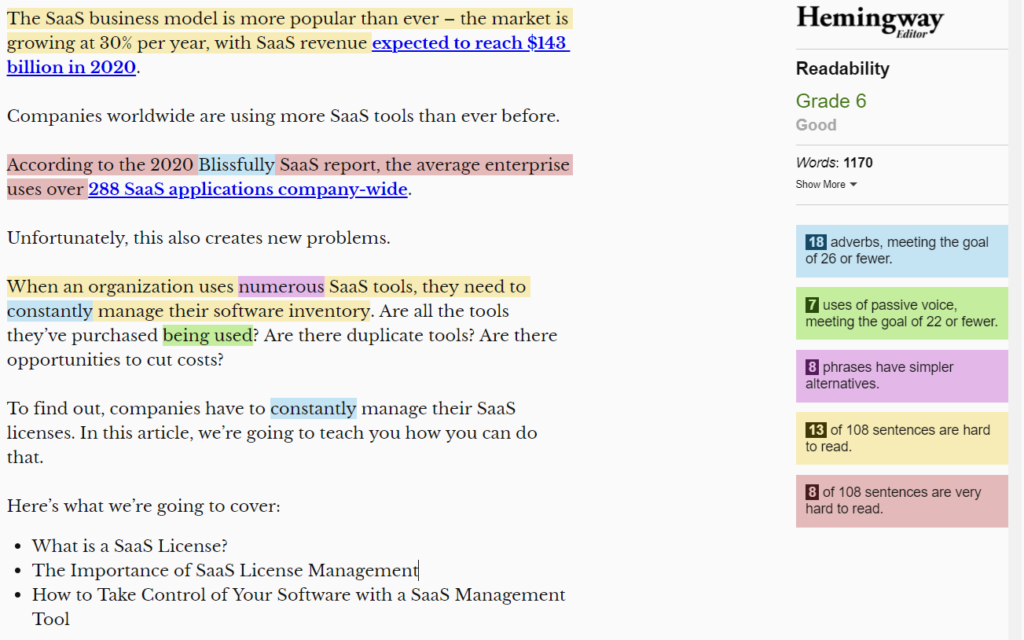
Are readability checkers the be-all, end-all of conversational content? Absolutely not. That said, such apps are particularly helpful for double-checking that your SaaS content isn’t needlessly complicated.
Here’s another example of a reader-friendly blog post, this time from ZoomInfo. Note how the introduction flows seamlessly and how phrases like “Let’s break that down” emulate spoken language.
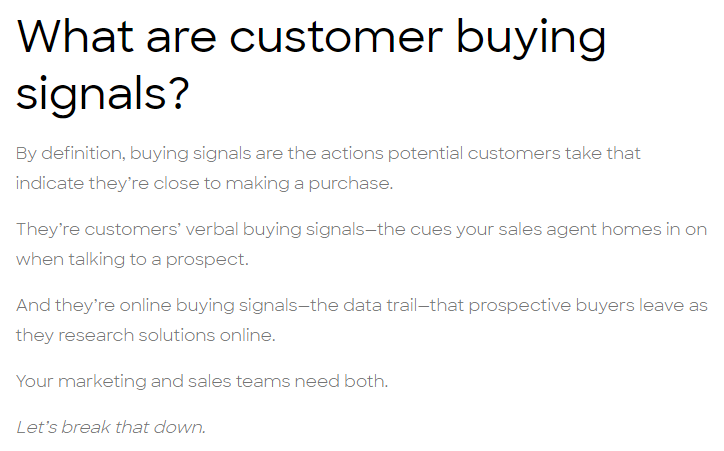
Sure, software companies (especially those in B2B SaaS) have the benefit of selling to a more sophisticated audience. These readers are likely prepared to dig for details and deal with dry blog posts.
But that doesn’t mean they should, right?
The ability to write conversational, readable content is what separates a professional SaaS writer from a non-writer producing content in-house. The former can break down high-level topics while the latter assumes far too much of the reader.
2. Put customer stories and real-world examples ahead of statistics
Statistics and data points are great for driving home the need for your SaaS product.
For example, saying that “[x]% of people waste [y] hours every week on [z]” is a compelling way to highlight how your service makes your customers’ lives easier.
But bashing your readers over the head with statistic after statistic isn’t an effective strategy for selling your product. Heck, even I have to be careful about statistic spam as a writer.
The takeaway here is that stats should supplement your SaaS content, not dominate it.
Instead, you should prioritize customer success stories and real-world user experiences to really emphasize how your service delivers on its promises.
Third-party stats highlighting your product’s importance are good, but firsthand stories are pure gold. As noted in my guide to SaaS case study examples, customer stories are the most effective type of content to influence purchasing decisions.
For example, companies like OptinMonster have blog posts dedicated to case studies. The positive results presented in their headlines speak for themselves. This is a brilliant example of how to combine customer stories with hard-hitting statistics that grab readers’ attention.
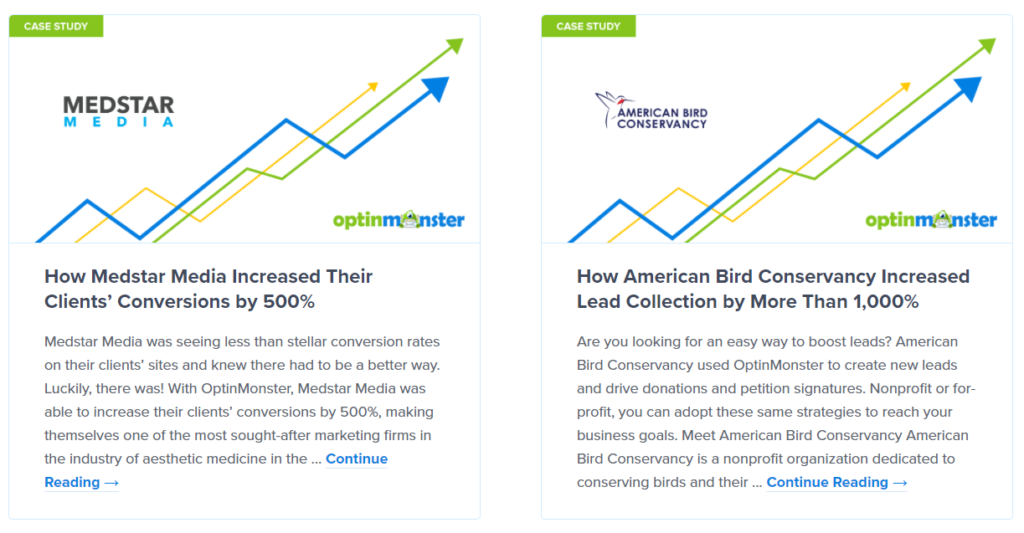
Piggybacking on our first tip, check out this snippet from one of Leadfeeder‘s customer stories. The Q&A format reads conversationally because it’s, well, an actual conversation.
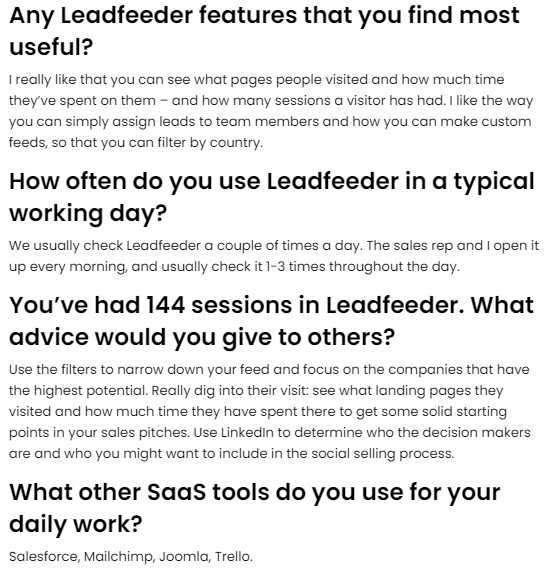
Meanwhile, the case study itself breaks down in plain English how an actual client uses their product, which features are their favorite and so on.
Real-life customer stories are much more tangible than statistics alone. Besides, interviewing customers and compiling case studies is crucial as part of your larger SaaS content marketing strategy.
3. Supplement your written SaaS content with screenshots, GIFs and videos
“Show, don’t tell.”
SaaS is visual by nature. Your product does stuff, doesn’t it? Show your readers what that stuff looks like in action.
I’m always baffled when I encounter SaaS content that’s totally devoid of examples or images.
Remember: your prospects aren’t mind-readers. Your blog post might be their first encounter with your industry. You can scream all day about how important CRM or marketing automation is, but it doesn’t mean much until they can see what CRM or marketing automation looks like in practice.
Chances are you’re already sitting on a ton of visual content from your knowledge base, anyhow.
Product screenshots. GIFs. Videos. Use ’em to show off your product.
For example, this post from Airtable showcases how you can go heavy on screenshots and GIFs to illustrate your points and make your SaaS content more actionable.
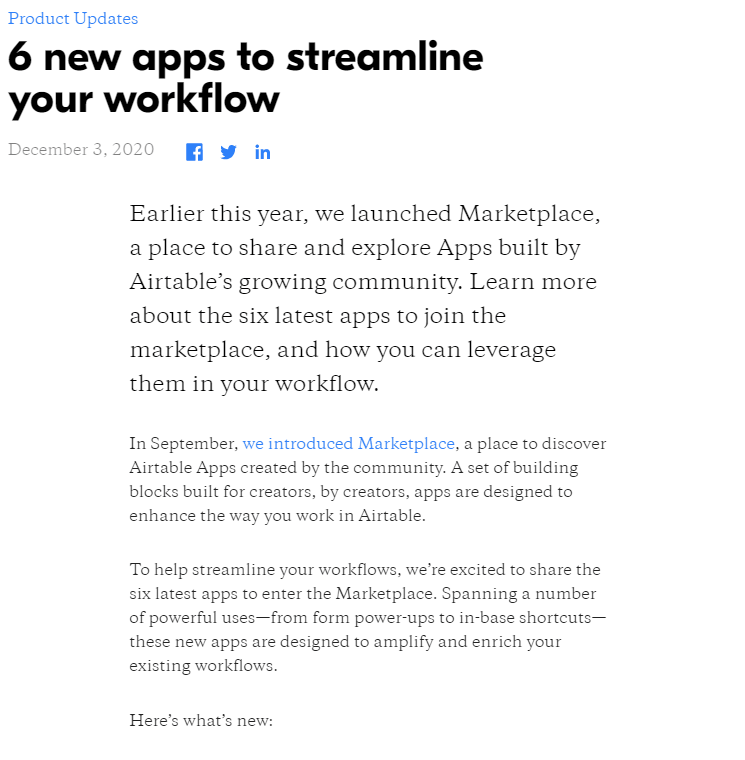
Here’s another example, this time from RingCentral. Incorporating video embeds into your blog posts is a smart move, especially to appeal to readers with microscopic attention spans. Videos can likewise illustrate features of your product that go beyond your initial post’s scope.
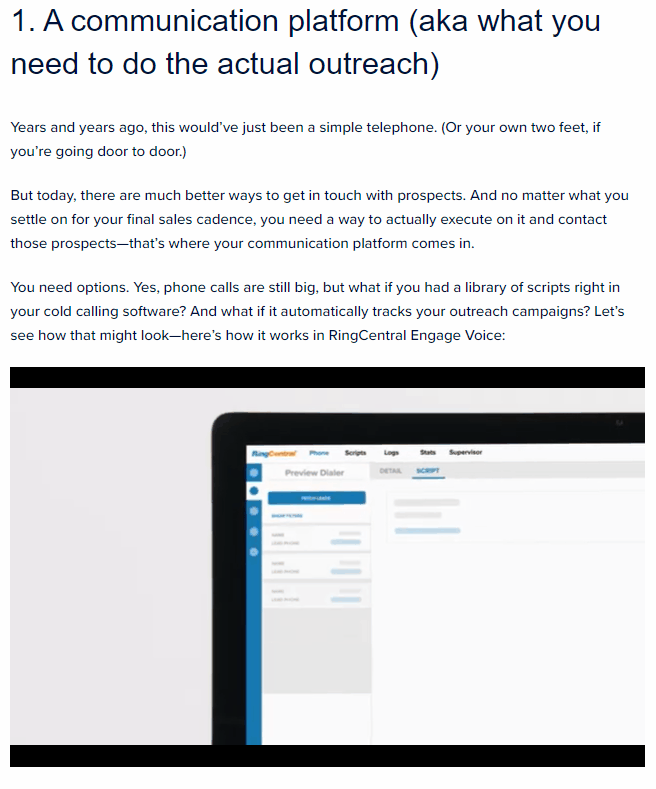
Anecdotally, I’ve found that my most example-heavy blog posts are the ones that perform the best for clients SEO-wise. If nothing else, such blog posts are typically more scannable and therefore more reader-friendly.
4. Create content for multiple levels of customer consideration
No huge surprises here.
In short, your SaaS content strategy should cover each stage of the buyer’s journey. This includes people who’ve never heard of you, folks on the fence about buying and current customers alike.
Below is a kitchen-table summary of those stages in the SaaS funnel:
- Top-of-funnel content for people who are problem-aware but unfamiliar with your particular solution
- Middle-of-funnel content for people in “research mode,” looking to learn more about your solution (but not quite ready to become paid customers)
- Bottom-of-funnel content for leads who need just a push to make a purchase
For example, Asana’s content strategy manages to cover all of the above. From general productivity tips to client use cases and product tutorials, each stage of the funnel is addressed.
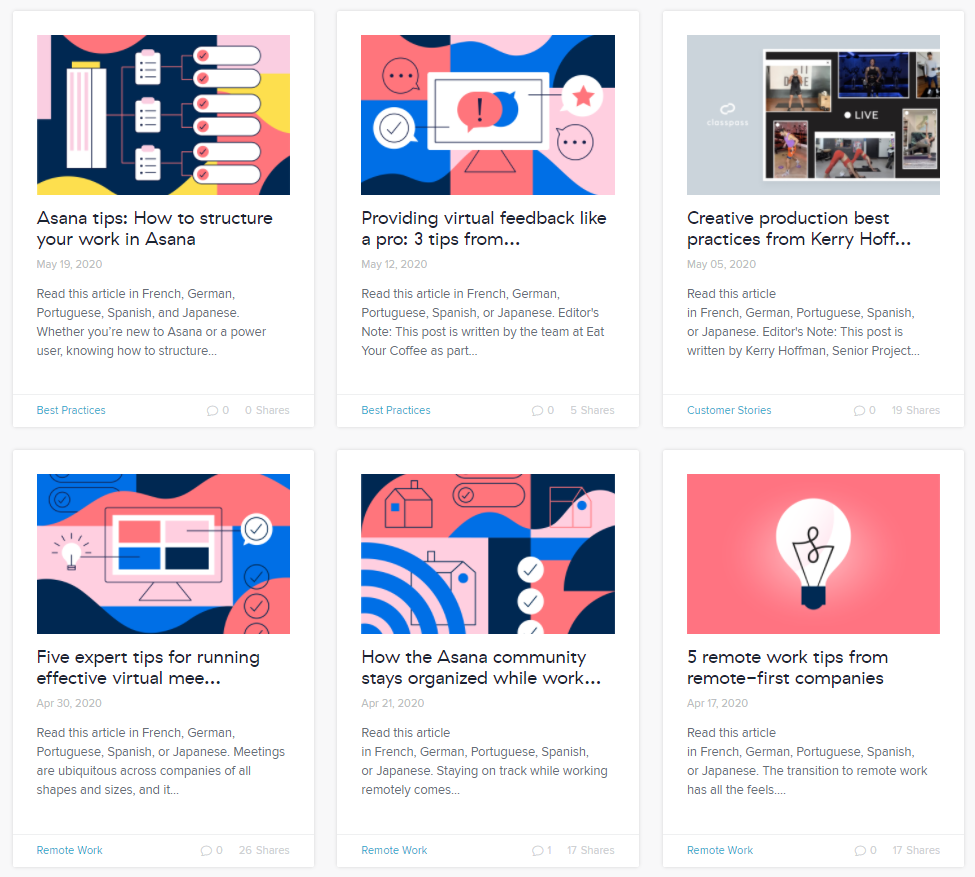
Covering a variety of topics allows you to appeal to a wider audience. For example, top-of-funnel content empowers you to educate people learning about your industry for the first time. On the flip side, middle and bottom-of-the-funnel posts let you take a deeper dive into your product and its features.
Oh, and covering a wider array of topics means more opportunities to target keywords for the sake of SEO. It’s a sort of win-win.
5. Promote positive outcomes alongside your product’s features
One of the oft-cited best practices of SaaS marketing is to push benefits over features.
However, consider how you can push both throughout your blog content.
This post from ClickUp is a great example. The premise of saving an entire day’s worth of work per week (benefit!) is compelling by itself. The post then drives home how ClickUp’s product (features!) can make it happen.
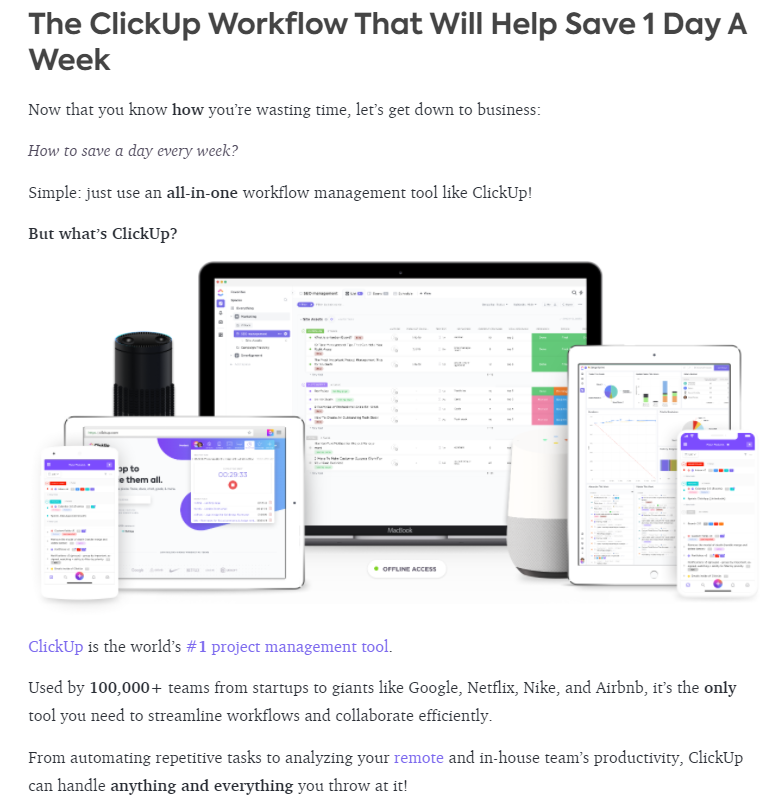
In other words, how do you achieve those ever-so-enticing benefits? Why do your promoted features matter? Give your readers the answers.
The takeaway here is that both benefits and features should be put into context. Don’t treat them as a matter of either-or. Talk about both. Doing so makes your product seem more actionable to potential customers.
6. Don’t push your product too hard in any given post
To wrap things up, remember that your written SaaS content is part of a larger customer journey.
Blogs are a prime place to nurture leads and encourage them to check out a demo of your product. That said, you need to mind how (and when) you ask.
Too many calls-to-action can be downright distracting. To avoid being too in-your-face, you should use product shout-outs and demo requests sparingly.
Note that this tip mostly applies to top-of-funnel content. If you’re writing a how-to product tutorial, more frequent call-outs are fine.
This post from Sendlane is a solid example of how to hype your product without spamming readers. By waiting until the last ~20% of the post to mention features, the product call-outs feel organic rather than aggressive. Wrapping up with a free trial invitation is a natural conclusion for someone who made their way through the entire post.
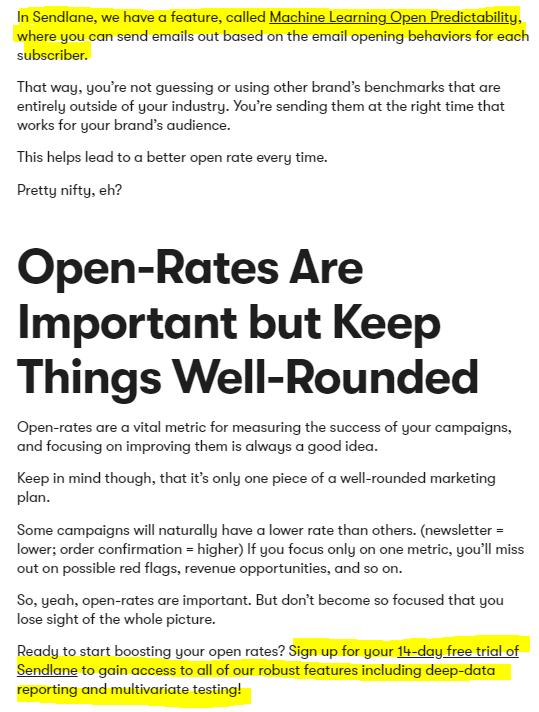
See how that works? You shouldn’t be shy about product mentions, but you should be strategic about them. Rather than always link demo pages, try integrating more internal links to other relevant blog posts.
Does your SaaS content make sense to readers?
With more and more SaaS companies pushing content, it’s crucial that what you put out there is crystal clear to your audience.
Doing so means producing posts that effectively educate readers rather than overwhelm them. In my experience, these principles are crucial to doing exactly that.
Got any additional tips for making your content SaaS content more reader-friendly? Let me know on Twitter, comment below or shoot me an email.
This post was last updated on 1/11/2021.
Great piece. I think we end to forget how customers consume media and you reminded me of the possibilities and how to make it easy to digest.